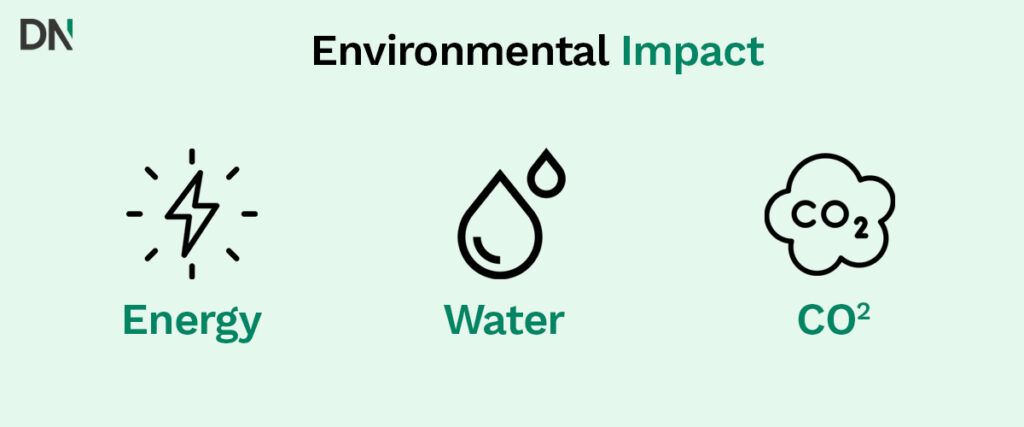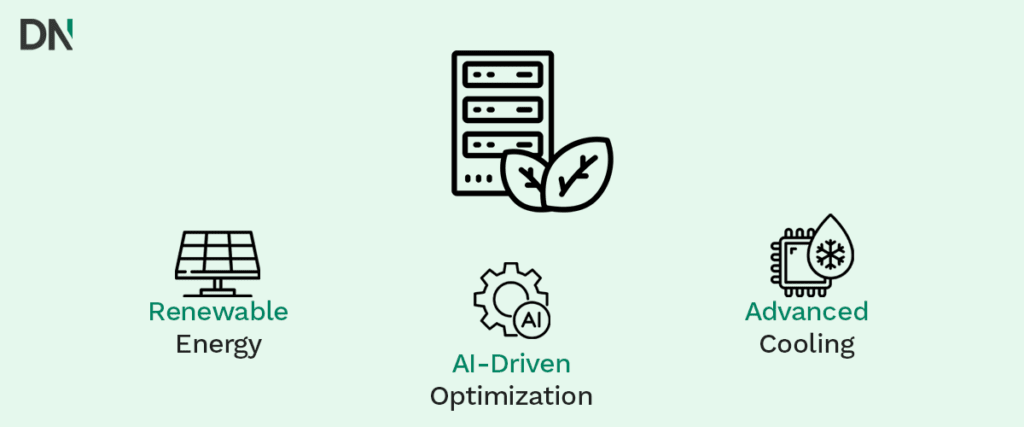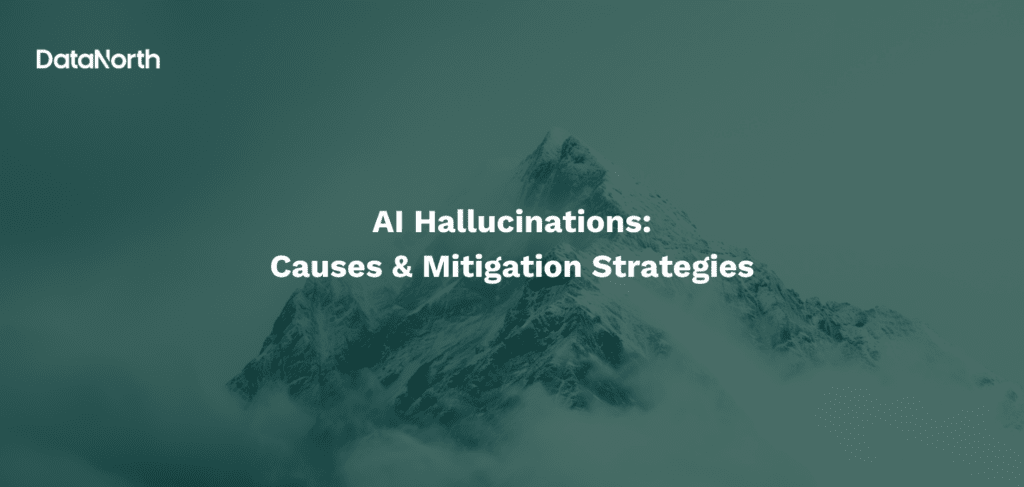LLMs and environmental impact
As large language models become increasingly powerful, organizations face a challenge: how to use AI while minimizing the environmental footprint. The environmental impact of LLMs extends far beyond their immediate energy consumption. This means encompassing everything from training emissions to water usage and hardware manufacturing. For businesses looking to build sustainable AI strategies, understanding and addressing these impacts will become increasingly important.
What is the environmental impact of an LLM?
Training a single large model like GPT-3 consumes approximately 1,287 megawatt-hours of electricity and generates around 552 metric tons of CO2 equivalent. This is roughly the equivalent to the lifetime emissions of 112 gasoline-powered cars. Even more striking, training newer models like GPT-4 is estimated to produce up to 21,660 metric tons of CO2 equivalent.
However, the environmental story doesn’t end with training. Once deployed, these models continue consuming energy with every query. Recent studies show significant variation in per-query consumption estimates, with newer research suggesting 0.3 watt-hours per query for optimized models like GPT-4o, while older estimates placed consumption at 2.9 watt-hours per query. Even at the lower estimate, this is about ten times more than a standard Google search. With billions of queries processed monthly, the aggregate inference costs likely exceed the one-time training emissions.
The water footprint is equally concerning. Google, Microsoft, and Meta alone used an estimated 580 billion gallons of water in 2022 for data center operations, with much of this water lost to evaporation and unable to return to the water cycle.

Hardware manufacturing adds another dimension to the environmental impact. GPU production is extraordinarily resource-intensive, requiring rare minerals and generating significant embodied carbon emissions. By 2030, CO2 emissions from GPU manufacturing alone are projected to reach 19.2 million metric tons, a 16-fold increase from 2024 levels.
Energy-efficient architectures and training strategies
Organizations can significantly reduce their AI environmental impact through strategic architectural choices and training optimizations. The key is moving beyond the “bigger is better” mentality to embrace efficiency-focused approaches.
Task-specific model optimization represents one of the most effective strategies. Rather than deploying massive general-purpose models, organizations should consider smaller, specialized models tailored to specific tasks, like small language models for example. Sparse models can reduce computations by 5 to 10 times compared to dense models, while maintaining comparable performance. For natural language processing tasks, choosing DistilBERT over BERT or GPT-3.5 Turbo over GPT-4 can provide similar outcomes with dramatically lower energy consumption.
Advanced training techniques can reduce energy consumption by up to 75% without significantly impacting performance. The Zeus optimization framework from the University of Michigan exemplifies this approach, dynamically adjusting GPU power limits and batch sizes during training to achieve substantial energy savings. Early stopping techniques prevent unnecessary GPU usage by halting training once validation improvements plateau, while GPUs typically account for about 70% of the power used in training deep learning models.
Model compression techniques offer powerful tools for reducing both training and inference energy requirements. Pruning can eliminate up to 90% of parameters while maintaining competitive accuracy. Besides that, quantization can reduce model size by 75-80% with minimal accuracy loss. Knowledge distillation creates smaller “student” models that retain 90-95% of the original model’s performance, as demonstrated by DistilBERT achieving nearly the same accuracy as BERT while using 40% fewer parameters.
Green data center practices
The infrastructure powering AI workloads offers significant opportunities for environmental improvement through advanced cooling systems, renewable energy adoption, and intelligent resource management.
Advanced cooling technologies are revolutionizing data center efficiency. Immersion cooling, where chips are submerged directly in non-conductive liquids, significantly reduces energy consumption compared to traditional air conditioning systems. Microsoft’s closed-loop cooling design prevents water evaporation by constantly circulating water between servers and chillers, eliminating the need for refilling. These systems, while more power-hungry than evaporative methods, can dramatically reduce water consumption.
AI-driven optimization is transforming data center operations. Google has achieved a 30% increase in cooling efficiency by using AI to optimize temperature and airflow based on real-time data. AI systems can predict energy generation patterns from renewable sources and adjust consumption accordingly, enabling data centers to draw more energy from green sources when they’re abundant.
Renewable energy integration is becoming standard practice among major cloud providers. Amazon, Meta, Google, and Microsoft continue to dominate the renewable power purchase agreement market. Small modular reactors (SMRs) are emerging as an innovative solution, offering carbon-free baseload power with a smaller footprint than traditional renewable installations, requiring less than 100 acres compared to 1,200-2,100 acres for a 300 MW solar farm.

How to build sustainable AI systems?
Efficiency by design should be embedded from the project’s inception rather than added as an afterthought. This includes:
- Optimizing algorithms for energy efficiency
- Reducing model size where feasible
- Leveraging low-power hardware
- Utilizing techniques like federated learning to reduce computational overhead.
Organizations should conduct sustainability impact assessments to evaluate the environmental impact of AI models during development, comparing different models and design choices based on their estimated carbon footprint.
Data efficiency and minimization can significantly reduce environmental impact. Rather than relying on massive datasets, organizations should leverage techniques like transfer learning, synthetic data generation, and self-supervised learning to lower data acquisition and storage energy costs.
Feature engineering can reduce the number of features by 34%, improving model performance while cutting energy use by approximately 9%.
Federated learning and edge computing offer promising alternatives to centralized training and inference.
- Federated learning enables collaborative model training across distributed clients while preserving data privacy and reducing the need for centralized data processing.
- Edge computing can reduce AI system energy consumption by enabling data processing closer to the source, eliminating the need for continuous data transmission to cloud servers.
Lifecycle management requires considering the entire AI system lifecycle, from development to decommissioning. This includes:
- Researching efficient means for sourcing and managing data
- Requiring third-party developers to incorporate sustainability into their development processes
- Engaging with hardware providers that have recycling programs for unusable hardware.
What does the future of sustainable AI look like?
The environmental impact of AI is increasingly becoming a business imperative rather than just an ethical consideration. Several factors are driving this shift:
- Growing regulatory pressure
- Evolving consumer expectations demanding sustainable practices
- Heightened investor scrutiny of environmental impact
- The potential for significant operational cost savings through energy efficiency
Organizations implementing sustainable AI practices report substantial benefits beyond environmental impact. Energy-efficient models reduce operational costs, improve deployment feasibility on resource-constrained devices, and enhance brand reputation through demonstrated environmental responsibility. Companies are finding that sustainable AI practices often align with improved performance and cost efficiency, challenging the notion that environmental responsibility requires performance trade-offs.
The regulatory landscape is evolving rapidly, with the EU and United States adopting stringent guidelines for new AI infrastructure. The Green Digital Action initiative, led by the International Telecommunication Union, is developing standardized metrics for AI’s energy consumption, water usage, and carbon emissions to foster sustainable AI practices across sectors.
Looking ahead
The key to sustainable AI lies in balancing innovation with responsibility. Current impact reduction strategies alone cannot curb the exponential growth in AI’s environmental impacts. Combining efficiency improvements with thoughtful deployment decisions can create meaningful change. Organizations that proactively address AI’s environmental impact will be better positioned to navigate future regulations, meet stakeholder expectations, and contribute to global sustainability goals.
The path forward requires a fundamental shift in how we approach AI development and deployment, moving from a pure performance focus to one that balances capability with environmental stewardship. This isn’t just about using less energy but it’s about building AI systems that are sustainable, responsible, and designed for a future where environmental impact is as important as technical capability.
As DataNorth AI, we recognize that sustainable AI isn’t just an environmental imperative. Organizations that embrace these practices today will be the leaders of tomorrow’s AI-driven economy, proving that technological innovation and environmental responsibility can go hand in hand. That’s why we offer an AI CO2 compensation program where we calculate the CO2 footprint generated by AI usage and partner up to plant trees offsetting the carbon emissions. So if you are looking for an environmentally responsible AI Partner, look no further.






